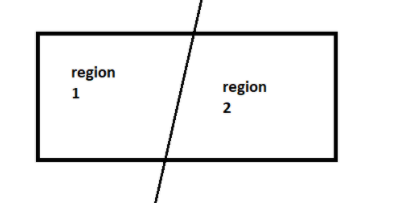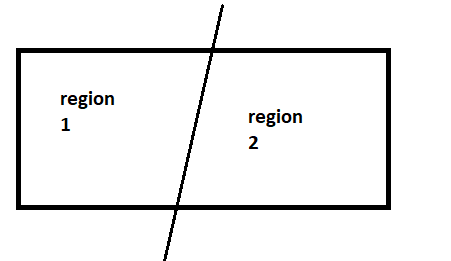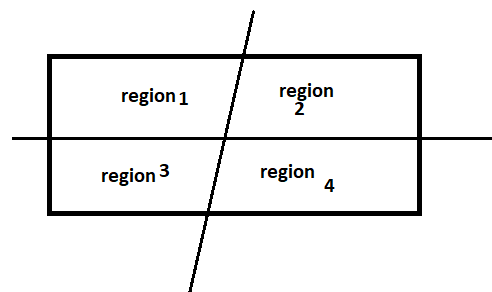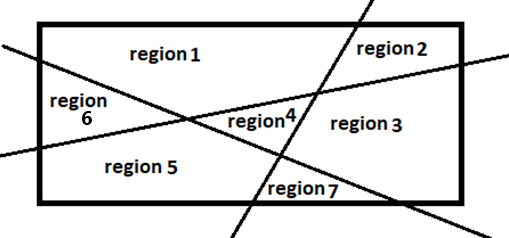
One line forms two regions in a plane. Similarly, two lines in a plane can form a maximum of four regions. These are shown in the figures.

What is the maximum number of regions that can be formed by 4 lines in a plane? Lines need not be concurrent.
A.7
B.8
C.10
D.11

Answer
572.7k+ views
Hint: At first we have given that One line forms two regions in a plane and two lines in a plane can form a maximum of four regions, similarly, we’ll find for the maximum number of regions for three lines.
From there we’ll get a particular type of series to easily determine the maximum regions made by four lines.
Complete step-by-step answer:
Given data: One line forms two regions in a plane
Two lines in a plane can form a maximum of four regions
Let's say that \[f\left( n \right)\] is the function resulting in the maximum regions that can be formed in a plane when n lines are there.
Now we know that one line forms 2 regions in a plane i.e.

Therefore, $f(1) = 2$
Similarly, it is given that two lines in a plane can form a maximum of four regions

Therefore, $f(2) = 4$
Similarly, we can check for three lines

Therefore, three lines in a plane can form a maximum of seven regions
Therefore, $f(3) = 7$
From the value of \[f\left( 1 \right),{\text{ }}f\left( 2 \right),\]and \[f\left( 3 \right)\] we can conclude that as the ${n^{th}}$ is include the maximum region increases by ‘n’
That is \[f(3) = f(2) + 3\]
\[ \Rightarrow f(3) = 4 + 3 = 7\]
Therefore, $f(4) = f(3) + 4$
On substituting the value of \[f\left( 3 \right)\] we get,
$ \Rightarrow f(4) = 7 + 4$
$\therefore f(4) = 11$
Therefore the required number of regions is 11.
Option(D) is correct.
Note: We can also proof the above solution as we found that
$f(1) = 2$ , $f(2) = 4$ and $f(3) = 7$
We can say that the no lines include we have one area as a whole
i.e. $f(0) = 1$
Now $f(1) - f(0) = 1$
$f(2) - f(1) = 2$
$f(3) - f(2) = 3$
.
.
.
$f(n) - f(n - 1) = n$
Adding all the above equations
$ \Rightarrow f(n) - f(0) = 1 + 2 + 3 + 4........ + n$
Now we know that sum of first n natural numbers is given by $\dfrac{{n(n + 1)}}{2}$
$ \Rightarrow f(n) - 1 = \dfrac{{n(n + 1)}}{2}$
Adding 1 on both sides
$ \Rightarrow f(n) = \dfrac{{n(n + 1)}}{2} + 1$
Now substituting $n = 4$
$ \Rightarrow f(4) = \dfrac{{4(5)}}{2} + 1$
$ = 10 + 1$
$ = 11$, which gives a similar answer as the above solution.
From there we’ll get a particular type of series to easily determine the maximum regions made by four lines.
Complete step-by-step answer:
Given data: One line forms two regions in a plane
Two lines in a plane can form a maximum of four regions
Let's say that \[f\left( n \right)\] is the function resulting in the maximum regions that can be formed in a plane when n lines are there.
Now we know that one line forms 2 regions in a plane i.e.

Therefore, $f(1) = 2$
Similarly, it is given that two lines in a plane can form a maximum of four regions

Therefore, $f(2) = 4$
Similarly, we can check for three lines

Therefore, three lines in a plane can form a maximum of seven regions
Therefore, $f(3) = 7$
From the value of \[f\left( 1 \right),{\text{ }}f\left( 2 \right),\]and \[f\left( 3 \right)\] we can conclude that as the ${n^{th}}$ is include the maximum region increases by ‘n’
That is \[f(3) = f(2) + 3\]
\[ \Rightarrow f(3) = 4 + 3 = 7\]
Therefore, $f(4) = f(3) + 4$
On substituting the value of \[f\left( 3 \right)\] we get,
$ \Rightarrow f(4) = 7 + 4$
$\therefore f(4) = 11$
Therefore the required number of regions is 11.
Option(D) is correct.
Note: We can also proof the above solution as we found that
$f(1) = 2$ , $f(2) = 4$ and $f(3) = 7$
We can say that the no lines include we have one area as a whole
i.e. $f(0) = 1$
Now $f(1) - f(0) = 1$
$f(2) - f(1) = 2$
$f(3) - f(2) = 3$
.
.
.
$f(n) - f(n - 1) = n$
Adding all the above equations
$ \Rightarrow f(n) - f(0) = 1 + 2 + 3 + 4........ + n$
Now we know that sum of first n natural numbers is given by $\dfrac{{n(n + 1)}}{2}$
$ \Rightarrow f(n) - 1 = \dfrac{{n(n + 1)}}{2}$
Adding 1 on both sides
$ \Rightarrow f(n) = \dfrac{{n(n + 1)}}{2} + 1$
Now substituting $n = 4$
$ \Rightarrow f(4) = \dfrac{{4(5)}}{2} + 1$
$ = 10 + 1$
$ = 11$, which gives a similar answer as the above solution.
Recently Updated Pages
Master Class 12 Business Studies: Engaging Questions & Answers for Success

Master Class 12 Economics: Engaging Questions & Answers for Success

Master Class 12 English: Engaging Questions & Answers for Success

Master Class 12 Maths: Engaging Questions & Answers for Success

Master Class 12 Social Science: Engaging Questions & Answers for Success

Master Class 12 Chemistry: Engaging Questions & Answers for Success

Trending doubts
What is meant by exothermic and endothermic reactions class 11 chemistry CBSE

Which animal has three hearts class 11 biology CBSE

10 examples of friction in our daily life

One Metric ton is equal to kg A 10000 B 1000 C 100 class 11 physics CBSE

1 Quintal is equal to a 110 kg b 10 kg c 100kg d 1000 class 11 physics CBSE

Difference Between Prokaryotic Cells and Eukaryotic Cells




